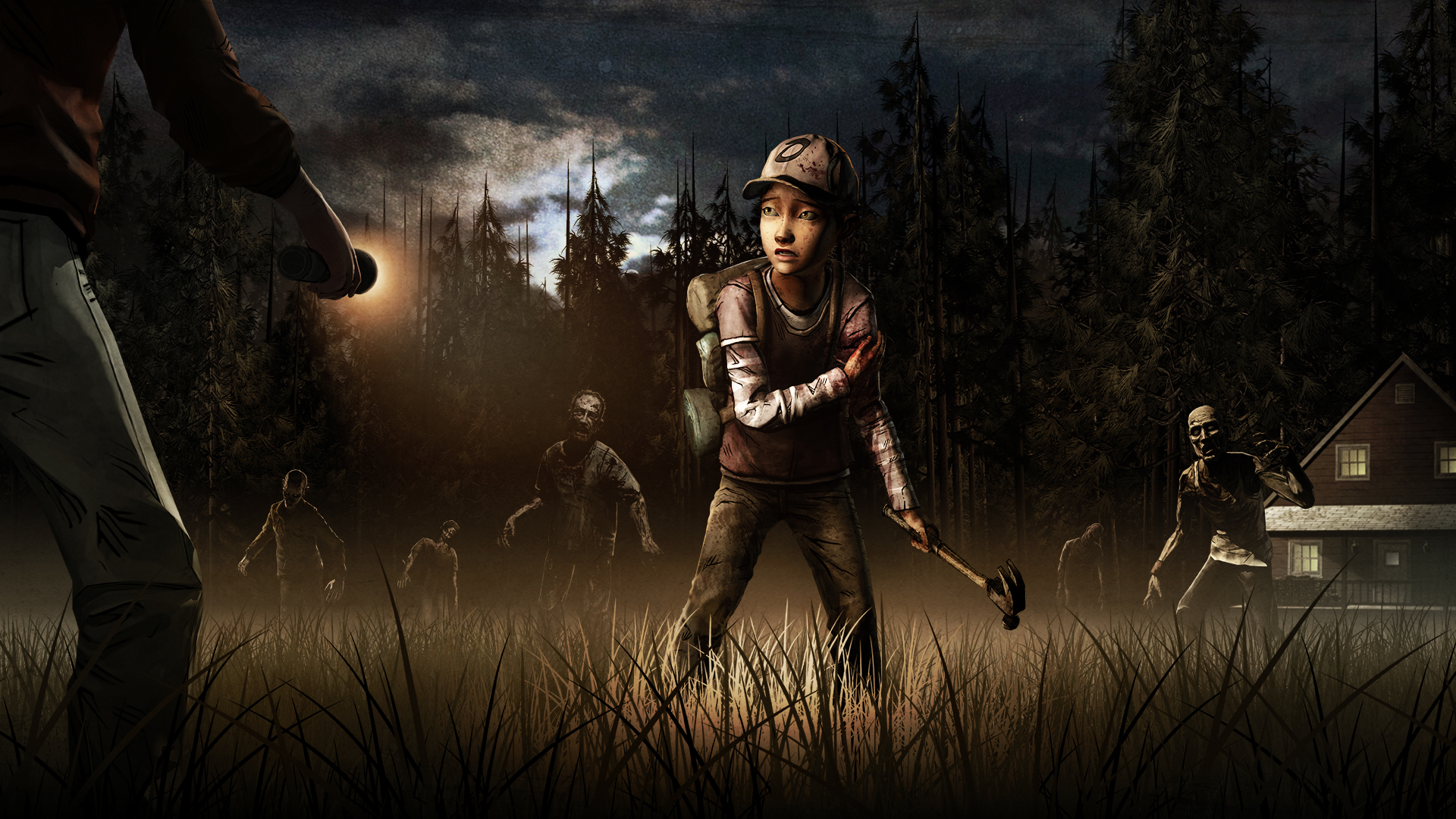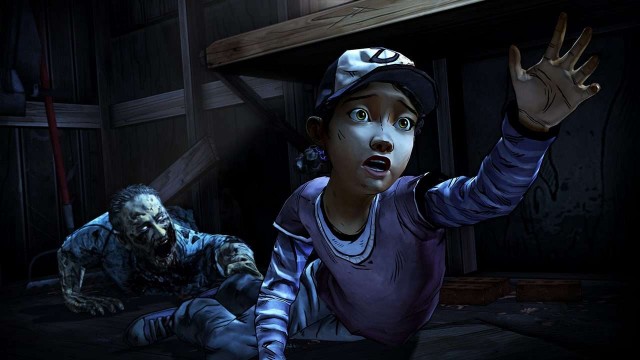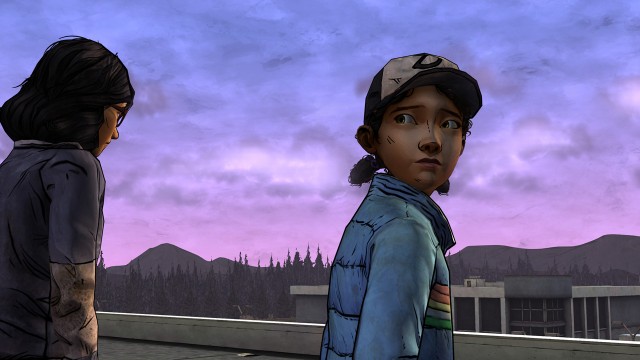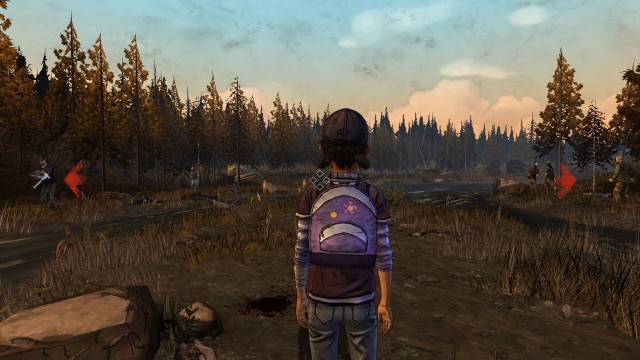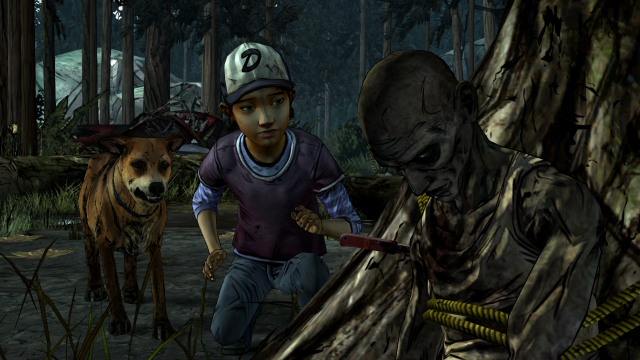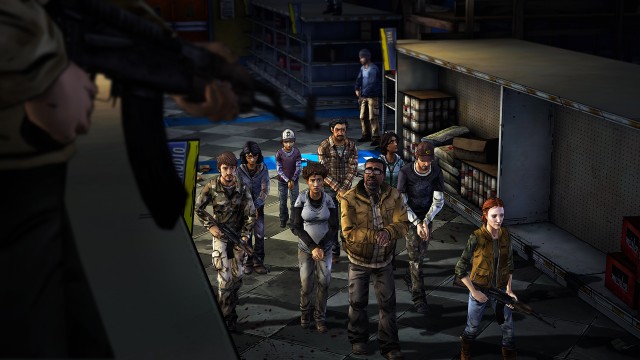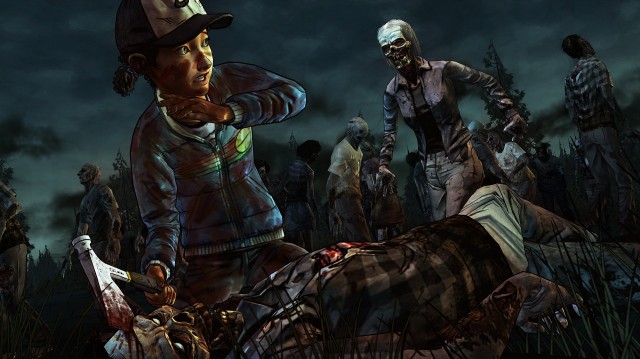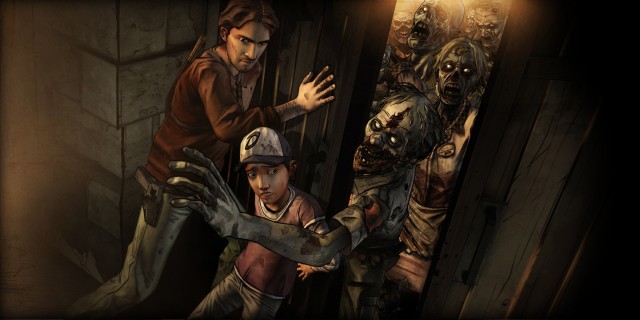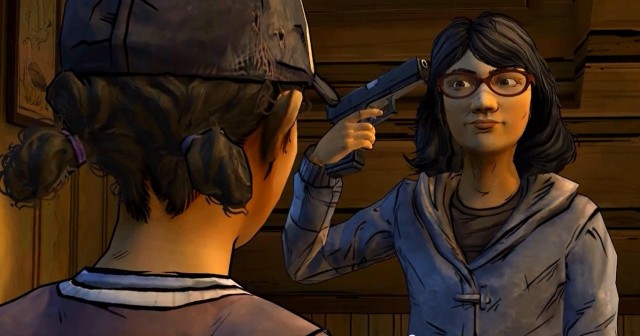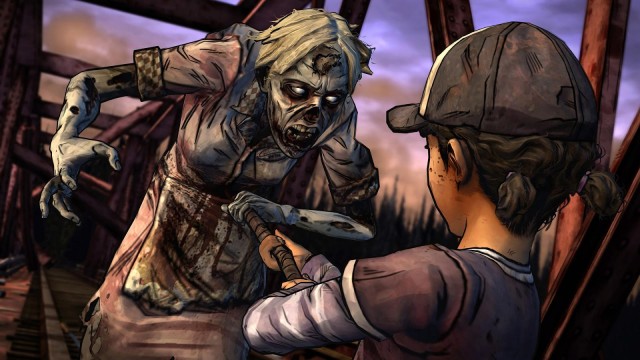NOTE: We have updated our review of The Walking Dead: Season Two to provide an additional section addressing impressions of the newly-released PlayStation 4 and Xbox One versions of the game.
By the time Telltale’s first five episodes of The Walking Dead had concluded, little girl, Clementine was left to fend for herself. The Walking Dead: Season Two picks up a handful of years afterward, with Clementine now just starting her adolescent years, and traveling with a new group of survivors. The world has become no less harsh, and death has become no less certain in the post-apocalyptic ruins of Georgia, but nonetheless, Clementine presses on in a desperate bid to survive the wastes of human society.
Yes, The Walking Dead: Season Two hasn’t gotten any cheerier, and its storytelling in particular maintains many of the strengths of its five preceding episodes that comprise Season One. The new five episodes continue to offer outstanding character work, particularly regarding how players can develop Clementine into a naive little girl, or a hardened survivor with increasing disregard for the welfare of others. The chilling atmosphere is also well intact, especially considering that the Telltale Tool engine continues to lend itself to some great-looking cel-shaded visuals, particularly for the rapidly-aging PS3 and Xbox 360.
For all of its maintained strengths however, The Walking Dead: Season Two does fall a tad shy of the outstanding final product of Season One. As much as Clementine is a great new player character, the novelty that was present in the original The Walking Dead episodes is a bit diminished the second time around, particularly since the second batch of five episodes doesn’t quite feel like it leaves the same impression. This is exacerbated by the vast majority of The Walking Dead: Season Two feeling more arbitrary in terms of gameplay, granting you less freedom to shape the game than Season One, and too often leaving episode gaps with little more than annoying cliffhangers, rather than actual weighty decisions that seem to carry any real lasting effects amidst your survivors and your world.
All minor issues considered however, The Walking Dead: Season Two is still a worthy follow-up to its predecessor overall, especially in regards to Clementine’s development. It’s just a shame that you might feel a tad more disconnected from everything else in Telltale’s zombie apocalypse the second time around.
The Walking Dead: Season Two has seen a minor visual bump over its predecessor. Characters and animations are slightly better defined, environments have a bit of added detail, and everything just looks a little more refined and polished in the second batch of episodes. With that said, The Walking Dead: Season Two isn’t quite as visually arresting as Telltale’s sibling episodic offering, The Wolf Among Us, which made far more appealing use of colour and lighting to create a world that is even more gripping and immersive.
Still, in such a bleak setting, maybe it’s understandable that The Walking Dead: Season Two looks a bit more understated. The cel-shaded visuals still suit the game very well though, and they look especially sharp on PC and Mac when the game is played on optimal settings. The game certainly doesn’t look bad on any of its platforms though, even if the portable versions no doubt take a hit in resolution and detail, particularly if you try to play on an iPhone.
At the very least, the coming Winter that serves as a threat in The Walking Dead: Season Two leads to more environmental variation than before. As much as the initial five episodes generally told a better overall story, the original game looks far more bland in comparison now, since The Walking Dead: Season Two does a noticeably better job of shifting between several more interesting and noteworthy locations. It at least lends to the second set of episodes having a greater sense of adventure and uncertainty than the first.
Obviously, some minor discrepancies are present in the graphics, depending on your platform of choice. Once again, Telltale seems most comfortable developing for PC and PS3, particularly since the PS3 version is arguably the most stable and sharp-looking of the ports available on dedicated gaming platforms. The Walking Dead: Season Two still looks mostly as good as the PS3 version on Xbox 360, but the Xbox 360 version still suffers from a few aliasing issues, has noticeably longer load times, and generally doesn’t seem to run quite as smoothly. The Xbox 360 build even freezes outright on rare instances, forcing you to exit and reload the game on Microsoft’s console.
The portable versions are at least more stable than the Xbox 360 version, even if the PS Vita version still suffers framerate drops, unlike its PS3 cousin. The PS Vita version still allows you to take the game on the go, and net yourself some easy trophies just for playing through it, but it chugs and stutters in a way that the other versions don’t (even the Xbox 360 version), so be warned about that. Things generally run more smoothly on iOS, with the iPad version looking almost on par with the console builds. The iPhone version has the worst visual resolution, but even it doesn’t suffer the framerate chugs that the PS Vita version does.
The Wolf Among Us may still stand as the best graphical work that the Telltale Tool has done at this point, but at least The Walking Dead: Season Two still looks plenty appealing, even if it’s mostly designed for last-gen hardware.
The Walking Dead: Season Two is still mostly devoid of music, much like its predecessor, allowing players to really immerse themselves in the game’s atmosphere. Still, the melancholy strings that play over the title menus continue to set the chilling mood nicely, as well as echoing the same menu tunes from the original five episodes.
Sound effects still continue to carry quite a lot of punch in the console and PC builds especially, sounding just as brutal and squeamish as they did in the first offering, even considering the colourful cel-shaded visual style. The portable versions are best played with headphones for the full effect, particularly in the iOS builds, but as long as you heed that condition, any build of The Walking Dead: Season Two makes every walker kill and survival death in particular feel appropriately stomach-turning.
As usual for Telltale however, the standout element of the audio in The Walking Dead: Season Two is the voice acting, which still sounds as fantastic as ever. Melissa Hutchison returns to voice Clementine, now in a slightly lower octave, as she’s aged a bit since the initial episodes, and a few other voice actors from the first game and The Wolf Among Us return here as well. Every survivor is voiced with incredible emotional conviction, regardless of their personalities, and while the writing sometimes lets down their strong backstories and motivations, they all continue to sound like real people with real thoughts and feelings. Likewise, any branch of Clementine’s potential dialogue leads to a satisfying response, as Clementine herself sounds equally credible as a savour or a survivor.
Thanks to the harsh audio and riveting dialogue, players will never struggle to be a part of Clementine’s latest adventures.
If you’ve played Season One of The Walking Dead, and chances are, you have if you’re even looking at The Walking Dead: Season Two, then the gameplay hasn’t really changed. The only real difference is that players are now controlling Clementine instead of Lee, though everything else pretty much remains the same.
The Walking Dead: Season Two is once again divided into five episodes, and each of them has Clementine proceeding on her journey in post-apocalyptic Georgia. For the most part, players will pick from several dialogue options to develop the story, with Clementine’s words and actions shaping the direction of certain plot events.
While it’s less often and prevalent than it was in Season One, Clementine’s actions may still lead to certain characters living or dying, or certain avenues of exploration and survival either opening up, or being closed off. Clementine is no longer seen as the strong leader that Lee was during Season One, but she’s still a voice of reason in one direction or the other, and she still has a surprising amount of bearing on the actions and feelings of her allies.
The story is more than enough to keep players engaged, though it is disappointing to see that players are given noticeably less room to navigate the world of The Walking Dead: Season Two on their own terms. It’s much more rare that players are actually allowed to wander around and interact with things and people at their own pace, and even then, it’s especially scripted this time around. Even Season One still mostly proceeded on rails, but The Walking Dead: Season Two almost constrains Clementine’s freedom too much, further eliminating true interactivity, and sometimes making players feel more like passive voices than actual participants.
Such may be the danger in the switch from Lee to Clementine in the player character role, but it’s an issue nonetheless. Fortunately, well-placed quick-time events still crop up during some harrowing action sequences, where players must press certain buttons, or perhaps aim a cursor to kill walkers, retrieve objects, or perhaps save someone during a heated time limit. As before, there’s not really a penalty for dying, since players can just reload a botched quick-time event and try again, and players don’t even have nearly as many chances to bite it in the second batch of episodes either.
The diminished impact of your decisions can often be a problem in The Walking Dead: Season Two, even if there are still some big choices that carry actual narrative weight, at least for a time. Episode 4 is a particular offender here, with more than one character dying no matter what, and players merely deciding to postpone the death, or let it happen right away. Episode 3 is also a bit frustrating in this respect, since it brings to the forefront a truly fantastic villain, and then starts a completely new story arc for episodes 4 and 5, making it feel like players have already outsmarted the biggest threat, and are simply left to meander around and mostly make small talk for the rest of these new episodes.
There’s no Book of Fables collectibles like in The Wolf Among Us either, with players simply scoring all of the achievements/trophies as they play normally and simply see the story through. It continues to make for easy ways to line your gamer accolades, but it gives the scenarios of the game even less reason to be replayed, since player decisions don’t dramatically alter events the way that they more often would during Season One.
If you continue to play on the same platform that you played Season One and perhaps its 400 Days DLC on, and kept your save file from Season One intact, you can load the file to continue having your decisions and actions carry over to The Walking Dead: Season Two. It’s still cool to see the outcome of certain decisions you made before, even back in Season One or 400 Days, and it’s still great to see that Telltale has created all sorts of minor dialogue tweaks, depending on what Clementine was encouraged to do by Lee before.
This still doesn’t change the fundamental issue of The Walking Dead: Season Two not creating as many interesting opportunities for decision-making as its predecessor though. The only real impact comes right at the conclusion of the season, which even contains three branching endings! Before that however, Clementine is only rarely allowed to be the adult that the series despeartely wants her to grow into with the player’s input, and she’s still not taken all that seriously by her group at times, despite the fact that she’s more skilled and smart than many of the survivors she meets.
With diminished novelty and engagement, The Walking Dead: Season Two mostly just feels like more of the same for the former episodes’ fans. Considering that you no doubt wouldn’t be playing The Walking Dead: Season Two without playing the initial episodes first though, perhaps this is fair enough. Just don’t expect any dramatic gameplay upgrades the second time around.
For all of its occasional storytelling issues, Telltale at least really got Clementine right once again. Clementine being forced to grow up during her pivotal years in the zombie apocalypse is really starting to take effect here, and the final resolution of the season in particular will really make you wonder where it all led to. Clementine remains a fantastic character, and it’s the continuation of her journey that really houses all of the appeal in The Walking Dead: Season Two.
Most of the other survivors are generally good personalities as well, even if some do simply exist to be killed off by bandits or walkers, but players no doubt won’t feel that they know them as intimately as they did most of Season One’s crew. The personalities and backstories are still mostly well-defined, but somehow, the circumstances and character arcs don’t mesh as seamlessly as they did in Season One.
A lot of this issue really comes from The Walking Dead: Season Two having a bizarre sense of problematic pacing. The first episode has to fumble around for establishment, and generally feels rushed and disorienting, while the second episode is a little better and easier to make sense of, and the third continues to elevate the story into an awesome new high, with an excellent and complex villain that really delivers a worthy foe to Clementine for the first time.
Sadly, this villain arc is swept under the rug for the fourth and fifth episodes, with the fourth episode being ok, but largely disappointing thanks to its meandering direction, and while the fifth episode ends well, it still feels like it’s wasting so much time with the survivors just stumbling around lost. Yes, it’s kind of the idea that they’re lost, but Season One at least had an approximate destination for the story. Here, the destination is a lot more unclear and disputed, and it seems like even Telltale themselves don’t always know where they’re headed with the plot.
Fortunately, Clementine’s arc still holds everything together. Even when the pacing gets weird, Clementine’s development will still keep players engaged. If there’s one story element that The Walking Dead: Season Two never fumbles, it’s the clear-cut arc to the kind of character that the player wants Clementine to be, with any of three results available, depending on your preferred direction for the character. It’s a shame, but these real payoffs are mostly confined to the end of episode five, with Telltale frustratingly buffering the new episodes with the illusion of choice in many places, rather than actual choice.
Again though, even if it’s sometimes a more trying journey, the destination is still worth it for fans, particularly for the promise that it sets up for the already-announced The Walking Dead: Season Three.
The most blatant upgrade on the next-gen consoles for The Walking Dead: Season Two is an improvement in resolution. Everything looks a bit sharper and more detailed on PS4 and Xbox One, compared to the Xbox 360 and PS3 versions, and is more in line with the highest visual potential of the PC version.
With that said though, there’s no other noticeable improvements to the experience, and for better or worse, The Walking Dead: Season Two, along with the combined episodes of its preceding season, is identical in every way on next-gen consoles as it was on last-gen consoles. In fact, it’s actually kind of disappointing that the next-gen versions of The Walking Dead: Season Two on PS4 and Xbox One don’t have more refinements, and feel a little slapdash. What’s more glaring is that they still seem to suffer from the same performance hiccups and bugs that the Xbox 360 and PS3 versions sometimes do, which feels pretty sloppy.
The Xbox One version does double the Gamerscore value of the same achievement roster from the Xbox 360 version, but the PS4 version offers no real perks over its PS3 predecessor, beyond the slight resolution bump.
Frankly, if you’ve already played through The Walking Dead: Season Two on any other platform, the PS4 and Xbox One versions present absolutely zero incentive to double-dip, and you’re best off ignoring them. If you’ve somehow passed up Telltale’s The Walking Dead games until now, and wish to play them on a next-gen console, you might as well pick them up for PS4 or Xbox One, but if you’ve already experienced both seasons on your trusty old Xbox 360 or PS3, you won’t find any real improvements in their next-gen offerings, which is rather disappointing.
Telltale sometimes hits a slump or two with The Walking Dead: Season Two, but the good still noticeably outweighs the bad. The decision to make Clementine the player character is a great one, even if it does lead to some decreased story influence, and anything that the original batch of episodes did especially well in terms of technology and atmosphere, the second offering still mostly maintains. Even with a few more flaws, The Walking Dead: Season Two still remains a wonderfully tragic and harsh character study, with an increasingly bleak situation bringing out the worst in good people.
It’s annoying that the Xbox 360 version of The Walking Dead: Season Two still suffers from the same optimization and stability issues, and the PS Vita version’s liberally chugging framerate drags down what is otherwise a sharp and well-presented portable variation of the game. The Xbox 360 version even has a handful of unique freezing and loading bugs, particularly in the later episodes, so expect a few more bumps on the journey if you’re playing on Microsoft’s console. If either of those happen to be your platforms of choice however, then none of these issues are dealbreakers, particularly since you have to be committed to the same platform that you played Season One on, should you want to carry over your former decisions from the earlier points in Telltale’s saga.
In any case, the conclusion of this chapter of Clementine’s journey will leave its share of promise to keep fans anticipating The Walking Dead: Season Three. Hopefully by then though, players will be presented with a branching narrative that they can more efficiently take part in.

